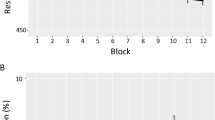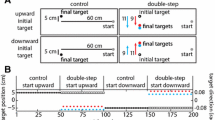Abstract.
To investigate the representation of motor sequence, we tested transfer effects in a motor sequence learning paradigm. We hypothesize that there are two sequence representations, effector independent and dependent. Further, we postulate that the effector independent representation is in visual/spatial coordinates, that the effector dependent representation is in motor coordinates, and that their time courses of acquisition during learning are different. Twelve subjects were tested in a modified 2×10 task. Subjects learned to press two keys (called a set) successively on a keypad in response to two lighted squares on a 3×3 display. The complete sequence to be learned was composed of ten such sets, called a hyperset. Training was given in the normal condition and sequence recall was assessed in the early, intermediate, and late stages in three conditions, normal, visual, and motor. In the visual condition, finger–keypad mapping was rotated 90° while the keypad–display mapping was kept identical to normal. In the motor condition, the keypad–display mapping was also rotated 90°, resulting in an identical finger–display mapping as in normal. Subjects formed two groups with each group using a different normal condition. One group learned the sequence in a standard keypad–hand setting and subsequently recalled the sequence using a rotated keypad–hand setting in the test conditions. The second group learned the sequence with a rotated keypad–hand setting and subsequently recalled the sequence with a standard keypad–hand setting in the test conditions. Response time (RT) and sequencing errors during recall were recorded. Although subjects committed more sequencing errors in both testing conditions, visual and motor, as compared to the normal condition, the errors were below chance level. Sequencing errors did not differ significantly between visual and motor conditions. Further, the sequence recall accuracy was over 70% even by the early stage when the subjects performed the sequence for the first time with the altered conditions, visual and motor. There were parallel improvements thereafter in all the conditions. These results of positive transfer of sequence knowledge across conditions that use dissimilar finger movements point to an effector independent sequence representation, possibly in visual/spatial coordinates. Initially the RTs were similar in the visual and the motor conditions, but with training RTs in the motor condition became significantly shorter than in the visual condition, as revealed by significant interaction for the testing stage and condition term in the repeated measures ANOVA. Moreover, using RTs for single key pressing in the three conditions as baseline indices, it was again observed that RTs in the visual and motor conditions were not significantly different in the early stage, but motor RTs became significantly shorter by the late testing stage. These results support the hypothesis that the motor condition benefits more than the visual because it uses identical effector movements to the normal condition. Further, these results argue for the existence of effector dependent sequence representation, in motor coordinates, which is acquired relatively slowly. The difference in the time course of learning of these two representations may account for the differential involvement of brain areas in early and late learning phases found in lesion and imaging studies.
Similar content being viewed by others
Author information
Authors and Affiliations
Additional information
Electronic Publication
Rights and permissions
About this article
Cite this article
Bapi, R., Doya, K. & Harner, A. Evidence for effector independent and dependent representations and their differential time course of acquisition during motor sequence learning. Exp Brain Res 132, 149–162 (2000). https://doi.org/10.1007/s002219900332
Received:
Accepted:
Issue Date:
DOI: https://doi.org/10.1007/s002219900332




